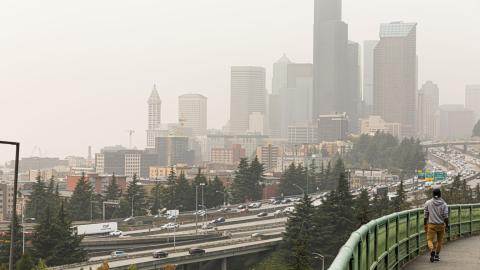All forest fire smoke is bad for people, but not all fires in forests are bad.
This is the conundrum faced by experts in forest management and public health: Climate change and decades of fire suppression that have increased fuels are contributing to larger and more intense wildfires and, in order to improve forest health and reduce these explosive fires, prescribed and managed fire is necessary.
These intentional fires — some deliberately set and others unintended but allowed to burn under control — will reduce the intensity of wildfire smoke in the long run, but they are still creating health-impacting smoke, often hitting populations least protected from exposure to smoke.
To find consensus on how to deal with the impacts of all fires on dry Western forests, the University of Washington and The Nature Conservancy led a series of conversations involving roughly 60 experts charged with keeping forests and people healthy. The Science for Nature and People Partnership led the organization of these discussions.
Living with fire
On May 2, more than two dozen of those participants published a paper in the journal Current Environmental Health Reports that is part review of current scientific understanding of the issues and health impacts and part consensus report on how to deal with them.
“It started as a conversation between experts who think about fire from really different angles in order to find how we can address fire through an interdisciplinary lens,” said lead author Savannah D'Evelyn, a postdoctoral fellow in UW Department of Environmental & Occupational Health Sciences (DEOHS). She is also a trainee in the UW Biostatistics, Epidemiologic and Bioinformatic Training in Environmental Health program, part of DEOHS.
“It took a little bit to get to the fact that it was really smoke that brought us all together. We kind of had to set a baseline for what peoples’ starting points were — all smoke is bad smoke from a public health perspective, but we can't do fire management without more fire.”
Agreement on six consensus statements
The working group agreed on six statements and recommendations as part of its interdisciplinary approach to the issues.
- We recognize the need to listen to and integrate a diversity of perspectives, in particular those embodied by Indigenous peoples who have successfully used fire as an ecological tool for thousands of years.
- Prescribed fires in addition to managed fires for resource benefit are both necessary management techniques to keep forests resilient and to lessen the negative ecological and public health impacts of wildfires.
- Certain regions of the Western U.S. will experience more smoke days with heightened use of prescribed and managed fire; however, we expect the impacts of smoke exposure to be reduced over the long term in comparison with untreated land burned by wildfires. With these techniques, exposure in affected communities can be planned and lessened.
- No degree of smoke exposure is without risk. However, additional investment in advance preparation for affected populations can lower associated health risks. A smoke-resilient community is resilient to smoke from any type of fire.
- We must work to promote both equity in process (e.g., who has a say in decision-making) and equity in outcomes (e.g., who gets exposed to the smoke) within those communities and populations experiencing disproportionate impacts from smoke.
- We are missing opportunities for positive impact by working as separate disciplines. We recommend that further and intentional integration of forest/fire and health disciplines (including the practitioners, tools and resources) needs to occur to lessen the human health effects of smoke exposure due to prescribed and managed fires.
“Extra attention must be given to people who have more smoke exposure, are more likely to experience health problems from smoke, and who don’t have enough support to anticipate, adapt, respond or recover from smoke,” added Dr. June Spector, senior author and DEOHS associate professor in the UW School of Public Health. “These disproportionately affected populations must be included in decision-making to address inequities in smoke health impacts.”




